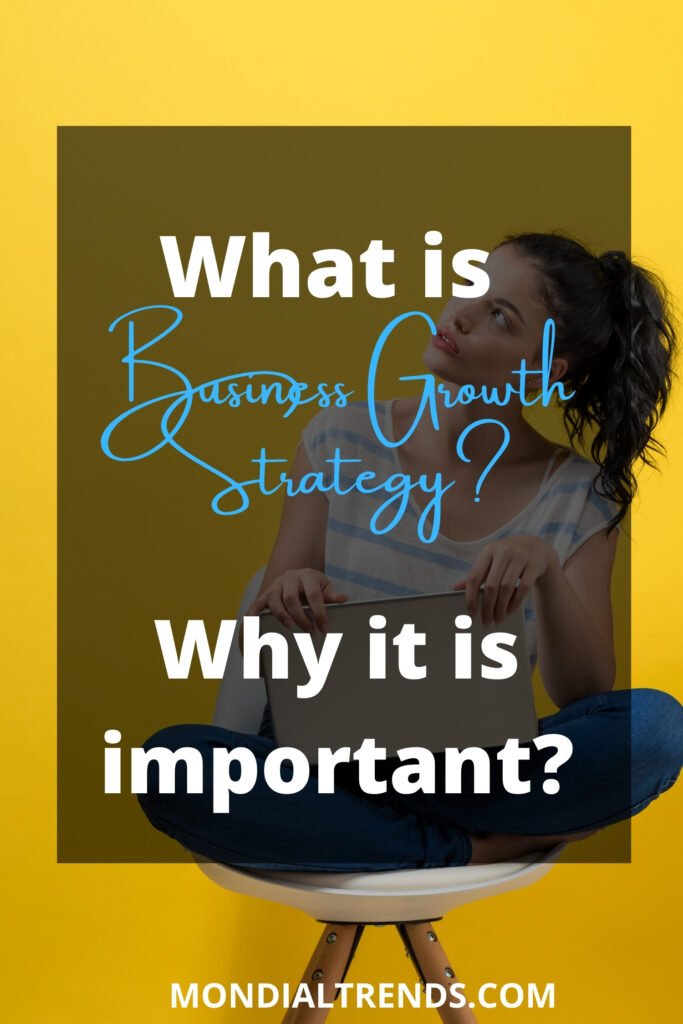What Is Business Growth Strategy? Why Is It Important?
Are you wondering why you can’t seem to attract your ideal clients or business isn’t growing month after month, year after year? Well, the reason could be because you have neglected or thought that having a business growth strategy was unnecessary or perhaps too complicated to follow through, or perhaps daily urgent problems and tasks take up all of your time, why this excuse is valid, it is equally essential to have a business growth strategy in place. Statistics have shown us how fundamental it is to have a business growth strategy for consistent growth.
Having a business strategy with details of your goals, tactics, and how you’re going to accomplish them can not be ignored. No one wants to remain stagnant, a business growth strategy serves as an essential tool for long-term business survival and boosts the credibility of your business.
It is important to plan your business growth and not wait for it to magically happen, you need to have a short-term and long-term detailed business growth strategy, it could be anywhere from a 6-month to 5-year plan to help you measure your business success.
The absence of a business growth strategy makes it hard to spot new opportunities and acquire new customers. You need to put your business in a position where you are invisible in the market to reduce the risk of premature business failure.
There are so many great ways you can grow your business, but it all comes down to your ambitions, resources, opportunities, and your reasons for growth. However, two crucial factors for choosing a business growth strategy exist. They are:
Products – what you currently offer, and what you’d like to offer in the future as a result changing business landscape.
Markets – where you currently sell, and where you’d like to sell in the future because you want to expand and keep growing.
According to Robert Izquierdo, business growth requires a game plan. Here are some real-life businesses with successful growth strategies.
Facebook is the biggest social media platform in the world today with 2.6 billion active users, but when it was launched in 2004, there were other social networks and MySpace was the biggest on the scene back then, this didn’t stop Facebook, they used a market penetration business growth strategy to beat their competitor.
First, they had to be clear about their target customer and gradually expanded the base.
Start small: Facebook began in the Harvard dorm room of Mark Zuckerberg. Consequently, the initial customer base was Harvard students.
Expand gradually: A soon as they had enough fans based in Harvard, Facebook decided to gradually expand to other colleges. This move allowed the company to grow using the same success model they used at Harvard.
Increase growth: Once they were present in several colleges and gaining traction, it was ready to open to non-students outside of colleges. With this move Facebook was able to remodel its product according to the needs of each new customer segment acquired, when their competitor was facing increased customer base challenges, and losing customers who were unsatisfied, Facebook was absorbing them into their platform.
MySpace wasn’t paying attention to its market and never saw past its short-term strategy which positioned them for eventual business extinction.
They entered the retail market in 1994, the internet wasn’t really a thing consumers were used to back then, and they hardly used it for shopping online but this didn’t stop Amazon from creating its business model around online shopping, they followed the path of diversification growth strategy and followed through which helped them grew to billions of dollars in annual sales.
Amazon was among the first to offer consumers the ability to buy online when the internet was still relatively new. They focused on value proposition by making life easy for consumers who wanted a better shopping experience.
Customer experience: They offered consumers great customer service by providing a larger selection of books that weren’t available in regular bookshops, by having an online presence they didn’t have to deal with limited shelf space, and within a few clicks consumers could easily check on Amazon’s website and see what book was in stock, unlike the regular bookstores. They offered convenience to consumers which was of great value to consumers.
Portfolio increase: Once they saw the success of their online book sales, they used the same tried and tested model to move into other product categories, and have continued to keep increasing their product offerings, today Amazon is the biggest online retailer in the world.
There are so many other great examples from Airbnb, Netflix, Uber, Google, and more.
So, where do you start and how do you develop your own business growth strategy? Start from the basics!
Define your target market: Identifying your target market and knowing who your business serves is an essential step for any business because if you decide to target everyone, it means you’re targeting no one and your message won’t attract the right customers to your business, thereby making it difficult to promote and grow your business.
According to a famous quote by Peter F. Drucker said,
“The aim of marketing is to know and understand the customer so well the product or service fits him and sells itself.”
You need to know your target market and how best to reach them with your marketing efforts.
Things to consider when doing this are:
- Demographics
- Geographic
- Psychographics
- Sociographic
- Behavioral
Once you understand these variables, it will be much easier to create products and services that serve them accordingly.
Have a compelling value proposition that actually solves a problem: According to Hubspot, 64% of businesses have “established value propositions”. A compelling value proposition makes your message clear to your ideal customers about your product offering and makes them feel confident that you can meet their needs, making you stand out from your competitors, it also attracts quality leads who are more likely to engage with your product offering.
Things to consider when doing this are:
- What you offer
- Who you serve
- Why you are different from the competitors
A well-crafted business value propositions have a massive potential to help your business attract the right customers to your business, but developing a good one can be quite challenging. Get an expert to help if you can’t do this part.
Focus on your key strengths and capabilities: To have a strategic advantage over the competition, requires looking deep within and tap into your inner capabilities to create a sustainable future for your business, today’s consumer appreciate businesses that care about people and the environment, consumer’s needs are always changing and innovative companies who understands these needs are coming out winning against the more established ones. Examples are healthy foods & beverages, electric cars, clean energy, fair trade, ethical tourism, green cosmetics etc.. Another way is outsourcing what you can’t do and focus all your attention on your key strengths, eliminate inefficiencies, find a strategic approach that works for you and your business.
Set milestones and keep track of your growth: According to mindtools, when setting milestones you have to be “SMART’’ about it, that way you have a clear vision of timelines for achieving your short- and long-term business objectives. With SMART you have:

Photo Credits:Canva
S: Specific goals and objectives set you up for success, so you should be clear, otherwise it will be difficult to focus your efforts on the goal you want to achieve. When drafting your goal, you should try as much as possible to brainstorm and answer the Why Who, How What, and When.
M: Measurable helps you stay motivated as you track each deadline and progress along the way on your business growth strategy. You feel more excited as you move closer to each milestone.
A: Achievable in the sense that it must be realistic and attainable for it to be successful. Sometimes we tend to overlook how much we can actually achieve with the right resources in place.
R: Relevant in a way that it actually aligns with your business growth strategy. We all need a little support in achieving our goals, but it’s important to retain control over them. So, make sure that your plans drive everyone forward, but that you’re still responsible for achieving your own goal.
T: Time-Bound which could range from 30 days, 60 days, 90 days, 6 months to 5 years Plan, keeping track of each milestone as your business progresses helps you to stay focused and motivated, you can also see where things are working or not, so you can tweak and improve where necessary. Regularly keep track of every progress to know the difference between where you are now and where you should be.
Every goal needs a target date so that you have a deadline to focus on and something to work toward. This part of the SMART goal criteria helps to prevent everyday tasks from taking priority over your longer-term goals.
Perform market research and look for new areas of opportunities: To be strategic with your business growth, it is also important to carry out market research from time to time, so you can anticipate what your customer base would want a few years down the line, Amazon brilliantly did this with their product categories which keep increasing, they were able to anticipate that someday consumers would also be interested in buying other things online besides buying a book. Today people do the majority of their online shopping on Amazon.
Identify and take actionable steps: Once you identify possible areas of opportunities that exist within your market, it is equally important to move fast with actionable steps to get the product or service on the market before someone else.
Be accountable and reassess your growth to ensure you’re headed in the right direction: Having some sort of accountability system in place doesn’t only keep you accountable, it also serves as a feedback tool where you get to review and see all the steps and milestones you have achieved or lacking. Also, if the task has been outsourced, having a system in place to periodically check to ensure it’s been done is also important.
Finally don’t forget to celebrate your success and wins as you go along getting things done. This is necessary to keep the morale and team spirit high, and acknowledge each milestone with your team. This will make them more productive and eager to reach more milestones with the company.
A business growth strategy is important, it is also imperative to take gradual actionable steps in executing each goal and measure the results to ensure you’re headed in the right direction and increase your chances of successfully growing your business.


Recent Comments